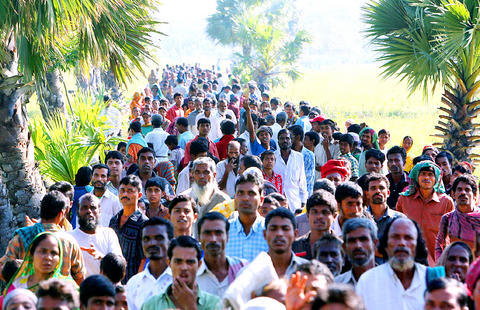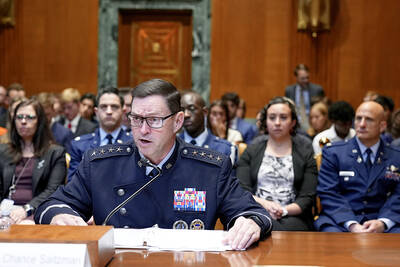Helicopters airlifted food to hungry survivors yesterday while rescuers struggled to reach remote areas devastated by Bangladesh's worst cyclone in a decade, amid fears the toll could be far higher than the official figure of 3,113.
The army helicopters carried mostly high-protein cookies supplied by the World Food Program (WFP), said Emamul Haque, a spokesman for the WFP office in Dhaka, which is coordinating international relief efforts.
International aid organizations promised initial packages of US$25 million during a meeting with Bangladesh agencies yesterday, Haque said.

PHOTO: AFP
The death toll hit 3,113 after reports finally reached Dhaka from storm-ravaged areas which had been largely cut off because of washed-out roads and downed telephone lines, said Lieutenant Colonel Main Ullah Chowdhury, a spokesman of the army coordinating the relief and rescue work.
The Bangladesh Red Crescent Society warned the toll could hit 10,000 once rescuers reach outlying islands, saying the estimate came from volunteers in rescue operations so far.
"The tragedy unfolds as we walk through one after another devastated village," said relief operator Mohammad Selim in Bagerhat, one of the worst-hit areas. "Often it looks like we are in a valley of death."
Grieving survivors had grim tales about losing loved ones.
In Galachipa, a fishing village along the coast in Patuakhali district, Dhalan Mridha and his family ignored the high cyclone alert issued by the authorities through radio and the Red Crescent volunteers.
When Mridha realized his mistake, it was too late.
"Just before midnight the winds came like hundreds of demons. Our small hut was swept away like a piece of paper and we all ran for shelter," said Mridha, a 45-year-old farm worker, weeping.
Mridha was separated from his wife, mother and two children while on his way to the shelter, a two-story building several blocks from his home. The next morning he found their bodies stuck up in a battered bush along the coast.
Mridha said he was too exhausted even to cry for their loved ones.
Local media described much of the coast as a vast valley of death and destruction, and said many grieving families buried their relatives in the same grave because they lacked any adult male survivors to dig graves.
While it will take several days to determine the number of dead and missing, some 3 million survivors who were either evacuated from the low-lying southern coast or whose homes and villages were destroyed will need support, the government said.
Relief items like tents, rice and water have been slow to reach many.
Government officials defended the relief efforts so far, and expressed confidence that authorities are up to the task.
"We have enough food and water," said Shahidul Islam, the top official in Bagerhat, a battered district near the town of Barguna. "We are going to overcome the problem."
Helicopters flew sorties to devastated areas, dropping food, drinking water and medicine for the survivors.
"But there are not many places where we can land," said one pilot, as large areas were still under water.
World Vision, one of many non-governmental groups working to help the cyclone survivors, said yesterday some 1,000 fishermen were still unaccounted for.
"Many of us climbed up on trees in the Sundarban forest, but I fell down in panic when I saw a tiger below," said a fisherman on Dublarchar island. "The waves then swept me further into the mangrove and I found myself alive when the cyclone was over."
The Sundarban forest, home to the endangered Royal Bengal Tiger and a World Heritage site, was badly hit.
Disaster Management Secretary Aiyub Bhuiyan met with representatives from the UN and international aid groups on Sunday to discuss the emergency response.
UN Secretary-General Ban Ki-moon said in a statement that several million dollars are available from the UN's emergency response funds, depending on the need.

FREEDOM OF NAVIGATION: The UK would continue to reinforce ties with Taiwan ‘in a wide range of areas’ as a part of a ‘strong unofficial relationship,’ a paper said The UK plans to conduct more freedom of navigation operations in the Taiwan Strait and the South China Sea, British Secretary of State for Foreign, Commonwealth and Development Affairs David Lammy told the British House of Commons on Tuesday. British Member of Parliament Desmond Swayne said that the Royal Navy’s HMS Spey had passed through the Taiwan Strait “in pursuit of vital international freedom of navigation in the South China Sea.” Swayne asked Lammy whether he agreed that it was “proper and lawful” to do so, and if the UK would continue to carry out similar operations. Lammy replied “yes” to both questions. The

Two US House of Representatives committees yesterday condemned China’s attempt to orchestrate a crash involving Vice President Hsiao Bi-khim’s (蕭美琴) car when she visited the Czech Republic last year as vice president-elect. Czech local media in March last year reported that a Chinese diplomat had run a red light while following Hsiao’s car from the airport, and Czech intelligence last week told local media that Chinese diplomats and agents had also planned to stage a demonstrative car collision. Hsiao on Saturday shared a Reuters news report on the incident through her account on social media platform X and wrote: “I

SHIFT PRIORITIES: The US should first help Taiwan respond to actions China is already taking, instead of focusing too heavily on deterring a large-scale invasion, an expert said US Air Force leaders on Thursday voiced concerns about the Chinese People’s Liberation Army’s (PLA) missile capabilities and its development of a “kill web,” and said that the US Department of Defense’s budget request for next year prioritizes bolstering defenses in the Indo-Pacific region due to the increasing threat posed by China. US experts said that a full-scale Chinese invasion of Taiwan is risky and unlikely, with Beijing more likely to pursue coercive tactics such as political warfare or blockades to achieve its goals. Senior air force and US Space Force leaders, including US Secretary of the Air Force Troy Meink and

Czech officials have confirmed that Chinese agents surveilled Vice President Hsiao Bi-khim (蕭美琴) during her visit to Prague in March 2024 and planned a collision with her car as part of an “unprecedented” provocation by Beijing in Europe. Czech Military Intelligence learned that their Chinese counterparts attempted to create conditions to carry out a demonstrative incident involving Hsiao, which “did not go beyond the preparation stage,” agency director Petr Bartovsky told Czech Radio in a report yesterday. In addition, a Chinese diplomat ran a red light to maintain surveillance of the Taiwanese